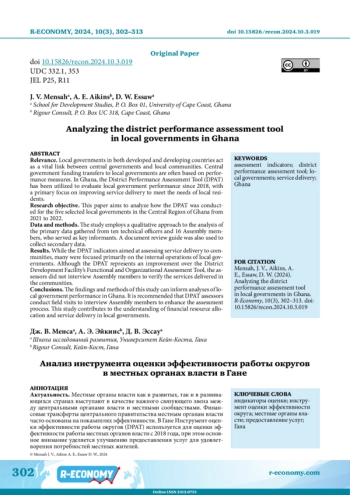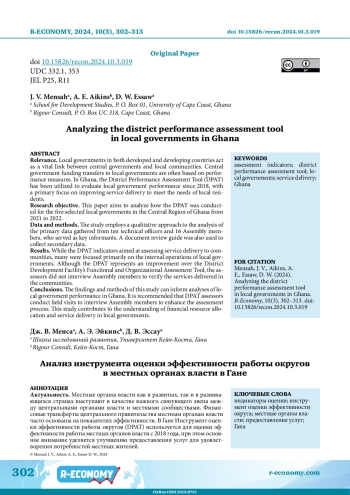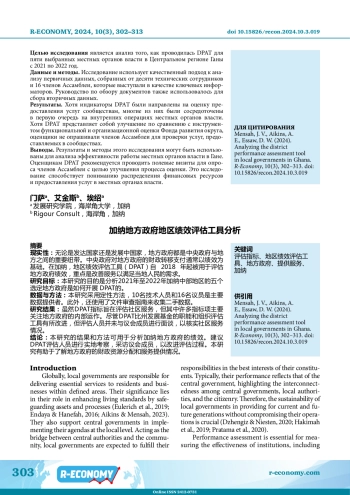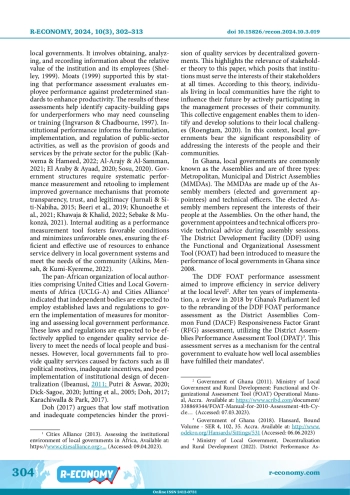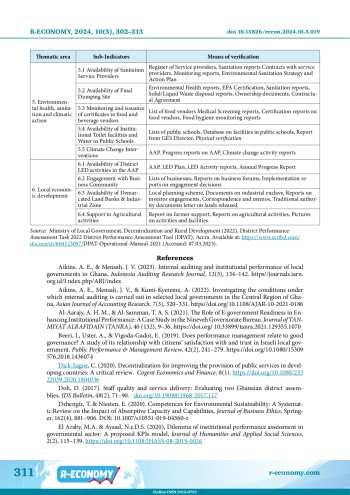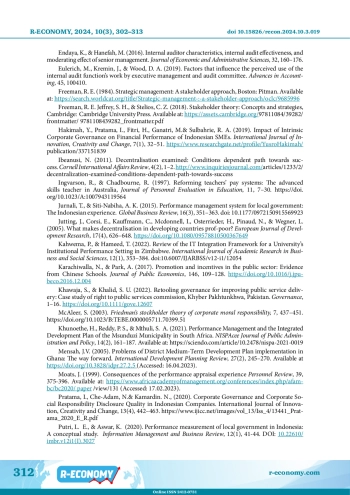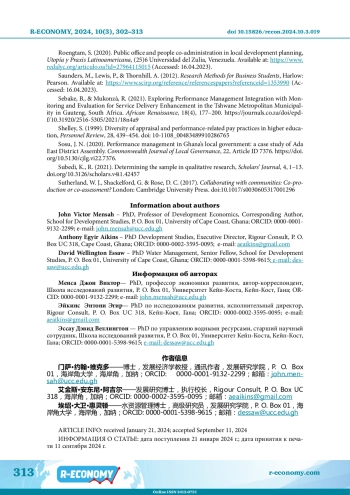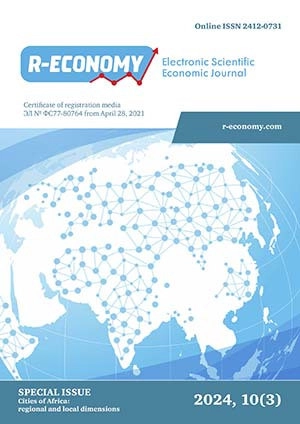Relevance. Local governments in both developed and developing countries act as a vital link between central governments and local communities. Central government funding transfers to local governments are often based on performance measures. In Ghana, the District Performance Assessment Tool (DPAT) has been utilized to evaluate local government performance since 2018, with a primary focus on improving service delivery to meet the needs of local residents. Research objective. This paper aims to analyze how the DPAT was conducted for the five selected local governments in the Central Region of Ghana from 2021 to 2022. Data and methods. The study employs a qualitative approach to the analysis of the primary data gathered from ten technical officers and 16 Assembly members, who served as key informants. A document review guide was also used to collect secondary data. Results. While the DPAT indicators aimed at assessing service delivery to communities, many were focused primarily on the internal operations of local governments. Although the DPAT represents an improvement over the District Development Facility’s Functional and Organizational Assessment Tool, the assessors did not interview Assembly members to verify the services delivered in the communities. Conclusions. The findings and methods of this study can inform analyses of local government performance in Ghana. It is recommended that DPAT assessors conduct field visits to interview Assembly members to enhance the assessment process. This study contributes to the understanding of financial resource allocation and service delivery in local governments.
Идентификаторы и классификаторы
Globally, local governments are responsible for delivering essential services to residents and businesses within defined areas. Their significance lies in their role in enhancing living standards by safeguarding assets and processes (Eulerich et al., 2019; Endaya & Hanefah, 2016; Aikins & Mensah, 2023). They also support central governments in implementing their agendas at the local level. Acting as the bridge between central authorities and the community, local governments are expected to fulfill their responsibilities in the best interests of their constituents. Typically, their performance reflects that of the central government, highlighting the interconnectedness among central governments, local authorities, and the citizenry. Therefore, the sustainability of local governments in providing for current and future generations without compromising their operations is crucial (Dzhengiz & Niesten, 2020; Hakimah et al., 2019; Pratama et al., 2020).
Список литературы
1. Aikins A. E., Mensah J. V. (2023).Internal auditing and institutional performance of local governments in Ghana, Indonesia Auditing Research Journal, 12(3), 134-142. https//journals.iarn.org.id/I ndex.php/ARJ/index.
2. Aikins A. E., Mensah J. V., Kumi-Kyereme A. (2022). Investigating the conditions under which internal auditing is carried out in selected local governments in the Central Region of Ghana, Asian Journal of Accounting Research, 7(3), 320-331. https//. DOI: 10.1108/AJAR-10-2021-0186 EDN: STNATG
3. Al-Aarajy A. H. M., Al-Samman T. A. S. (2021). The Role of E-government Readiness in Enhancing Institutional Performance: A Case Study in the Nineveh Governorate Bureau. Journal of TANMIYAT ALRAFIDAIN (TANRA), 40 (132), 9-36. DOI: 10.33899/tanra.2021.129355.1070
4. Beeri I., Uster A., Vigoda-Gadot E. (2019). Does performance management relate to good governance? A study of its relationship with citizens’ satisfaction with and trust in Israeli local government. Public Performance & Management Review, 42(2), 241-279. DOI: 10.1080/15309576.2018.1436074
5. Dick-Sagoe C. (2020). Decentralization for improving the provision of public services in developing countries: A critical review. Cogent Economics and Finance, 8(1). DOI: 10.1080/23322039.2020.1804036 EDN: ABORRS
6. Doh D. (2017). Staff quality and service delivery: Evaluating two Ghanaian district assemblies. IDS Bulletin, 48(2), 71-90. DOI: 10.19088/1968-2017.117
7. Dzhengiz T., Niesten E. (2020).Competences for Environmental Sustainability: A Systematic Review on the Impact of Absorptive Capacity and Capabilities, Journal of Business Ethics, Springer, 162(4), 881-906. DOI: 10.1007/s10551-019-04360-z
8. El Araby M. A., Ayaad N. e. D. S. (2020), Dilemma of institutional performance assessment in governmental sector: A proposed KPIs model, Journal of Humanities and Applied Social Sciences, 2(2), 115-139. DOI: 10.1108/JHASS-08-2019-0026 EDN: DGKDXD
9. Endaya K., Hanefah M. (2016).Internal auditor characteristics, internal audit effectiveness, and moderating effect of senior management. Journal of Economic and Administrative Sciences, 32, 160-176.
10. Eulerich M., Kremin J., Wood D. A. (2019). Factors that influence the perceived use of the internal audit function’s work by executive management and audit committee. Advances in Accounting, 45, 100410.
11. Freeman R. E. (1984). Strategic management: A stakeholder approach, Boston: Pitman. Available at: https://search.worldcat.org/title/Strategic-management-:-a-stakeholder-approach/oclc/9685996.
12. Freeman R. E. Jeffrey S. H., Stelios C. Z. (2018). Stakeholder theory: Concepts and strategies, Cambridge: Cambridge University Press. Available at: https://assets.cambridge.org/97811084/39282/frontmatter/9781108439282_frontmatter.pdf.
13. Hakimah Y., Pratama I., Fitri H., Ganatri M., Sulbahrie R. A. (2019). Impact of Intrinsic Corporate Governance on Financial Performance of Indonesian SMEs.International Journal of Innovation, Creativity and Change, 7(1), 32-51. https://www.researchgate.net/profile/YusroHakimah/publication/337151839.
14. Ibeanusi N. (2011). Decentralisation examined: Conditions dependent path towards success. Cornell International Affairs Review, 4(2), 1-2. http://www.inquiriesjournal.com/articles/1233/2/decentralization-examined-conditions-dependent-path-towards-success.
15. Ingvarson R., Chadbourne R. (1997). Reforming teachers’ pay systems: The advanced skills teacher in Australia, Journal of Personnel Evaluation in Education, 11, 7-30. :1007943119564. DOI: 10.1023/A EDN: AJQGIP
16. Jurnali T., Siti-Nabiha A. K. (2015). Performance management system for local government: The Indonesian experience. Global Business Review, 16(3), 351-363. DOI: 10.1177/0972150915569923
17. Jutting J., Corsi E., Kauffmann C., Mcdonnell I., Osterrieder H., Pinaud N., Wegner L. (2005). What makes decentralisation in developing countries prof-poor? European Journal of Development Research, 17(4), 626-648. DOI: 10.1080/09578810500367649 EDN: PQXKAW
18. Kahwema P., Hameed T. (2022). Review of the IT Integration Framework for a University’s Institutional Performance Setting in Zimbabwe.International Journal of Academic Research in Business and Social Sciences, 12(1), 353-384. DOI: 10.6007/IJARBSS/v12-i1/12054 EDN: ZVEPTV
19. Karachiwalla N., Park A. (2017). Promotion and incentives in the public sector: Evidence from Chinese Schools. Journal of Public Economics, 146, 109-128. DOI: 10.1016/j.jpubeco.2016.12.004
20. Khawaja S., Khalid S. U. (2022). Retooling governance for improving public service delivery: Case study of right to public services commission, Khyber Pakhtunkhwa, Pakistan. Governance, 1-16. DOI: 10.1111/gove.12607
21. McAleer S. (2003). Friedman’s stockholder theory of corporate moral responsibility, 7, 437-451. :TEBE.0000005711.70399.51. DOI: 10.1023/B
22. Khunoethe H., Reddy P. S., Mthuli S. A. (2021). Performance Management and the Integrated Development Plan of the Msunduzi Municipality in South Africa. NISPAcee Journal of Public Administration and Policy, 14(2), 161-187. Available at: https://sciendo.com/article/. DOI: 10.2478/nispa-2021-0019 EDN: ZQPKXQ
23. Mensah J. V. (2005). Problems of District Medium-Term Development Plan implementation in Ghana: The way forward.International Development Planning Review, 27(2), 245-270. Available at 10.3828/idpr.27.2.5 (Accessed: 16.04.2023). DOI: 10.3828/idpr.27.2.5(Accessed
24. Moats J. (1999). Consequences of the performance appraisal experience Personnel Review, 39, 375-396. Available at: https://www.africaacademyofmanagement.org/conferences/index.php/afambc/bc2020/paper /view/131 (Accessed: 17.02.2023).
25. Pratama I., Che-Adam N., Kamardin N. (2020). Corporate Governance and Corporate Social Responsibility Disclosure Quality in Indonesian Companies.International Journal of Innovation, Creativity and Change, 13(4), 442-463. https://www.ijicc.net/images/vol_13/Iss_4/13441_Pratama_2020_E_R.pdf.
26. Putri L. E., Aswar K. (2020). Performance measurement of local government in Indonesia: A conceptual study. Information Management and Business Review, 12(1), 41-44. DOI: 10.22610/imbr.v12i1(I).3027 EDN: CFSGYC
27. Roengtam S. (2020). Public office and people co-administration in local development planning, Utopía y Praxis Latinoamericana, (25)6 Universidad del Zulia, Venezuela. Available at: https://www.redalyc.org/articulo.oa?id=27964115015 (Accessed: 16.04.2023).
28. Saunders M., Lewis P., Thornhill A. (2012). Research Methods for Business Students, Harlow: Pearson. Available at: https://www.scirp.org/reference/referencespapers?referenceid=1353990 (Accessed: 16.04.2023).
29. Sebake B., Mukonzà R. (2021). Exploring Performance Management Integration with Monitoring and Evaluation for Service Delivery Enhancement in the Tshwane Metropolitan Municipality in Gauteng, South Africa. African Renaissance, 18(4), 177-200. https://journals.co.za/doi/epdf/. DOI: 10.31920/2516-5305/2021/18n4a9 EDN: SYMYNH
30. Shelley S. (1999). Diversity of appraisal and performance-related pay practices in higher education, Personnel Review, 28, 439-454. doi: 10-1108_00483489910286765. EDN: EBHIGL
31. Sosu J. N. (2020). Performance management in Ghana’s local government: a case study of Ada East District Assembly.Commonwealth Journal of Local Governance, 22, Article ID 7376. DOI: 10.5130/cjlg.vi22.7376 EDN: JHTKKA
32. Subedi K., R. (2021). Determining the sample in qualitative research, Scholars’ Journal, 4, 1-13. DOI: 10.3126/scholars.v4i1.42457
33. Sutherland W. J., Shackelford G., Rose D. C. (2017). Collaborating with communities: Co-production or co-assessment? London: Cambridge University Press. DOI: 10.1017/s0030605317001296
Выпуск
Другие статьи выпуска
Relevance. The study of inclusive economic growth remains highly relevant as the concept of growth continues to evolve. Measuring and analysing its determinants offers opportunities to foster inclusive growth at both regional and national levels. Research Objective. This study analyses inclusive economic growth in East Java’s districts and cities from 2018-2022 by comparing two measurement models: the Social Mobility Curve (SMC), which focuses on income distribution and economic growth, and the Poverty Equivalent Growth Rate (PEGR), which incorporates poverty, inequality, and unemployment. Data and Method. Using data from Statistics Indonesia (BPS), the National Labour Force Survey (SAKERNAS), and the National Socioeconomic Survey (SUSENAS) for 2018-2022, this study applies the SMC and PEGR models and conducts panel data regression to analyse inclusive growth and its determinants. Results. The findings reveal that economic growth in East Java lacks inclusivity. Income distribution inequality persists across districts and cities, as shown by the SMC results. The PEGR model also indicates ongoing challenges in reducing poverty and unemployment inclusively. Key factors such as the share of manufacturing in GRDP and employment opportunities significantly impact inclusive growth. Conclusions. Encouraging investment growth can create a favourable business climate across all districts/cities, supporting a more equitable contribution to GRDP. As employment opportunities play a significant role in inclusive growth, boosting employment through investment can improve access to education and healthcare, while addressing unemployment. To combat inequality and poverty, the government must refine its data collection on the poor to better target beneficiaries.
Relevance. External shocks can disrupt stable industrial development and technological modernization, especially in open single-industry regions that are highly vulnerable to global market fluctuations. The dominance of a single sector results in structural inertia, making it difficult for these regions to shift their economic trajectory. This path dependence amplifies the risks posed by economic turbulence, highlighting the need for changes in the economic structure and strategic guidelines for regional industrial policies. Objective. This study aims to describe the current, strategic, and future development paths for single-industry regions amid economic turbulence. It focuses on changes in the industrial profiles of metallurgical regions in Russia, including Lipetsk, Vologda, Murmansk, Sverdlovsk, Chelyabinsk, and Krasnoyarsk. Data and methods. The research uses publicly available statistics from 2008 to 2021, grounded in regional development theory. Methodologically, the study relies on coefficient analysis, positional-dynamic analysis, and assessment of technological connections between sectors. Results. The study has detected significant differences in regional adaptation: Lipetsk and Chelyabinsk are shifting towards low-tech sectors, Sverdlovsk maintains its metallurgical focus, Vologda is balancing metallurgy and a medium-high-tech chemical industry, while Murmansk and Krasnoyarsk are transforming with a focus on low-tech mineral extraction. Promising specializations include machine engineering in Sverdlovsk and Vologda, as well as machine engineering and electrical equipment production in Lipetsk and Chelyabinsk. However, we found discrepancies between the declared strategic goals and actual priorities in Lipetsk and Chelyabinsk. Conclusions. The findings offer valuable insights for policymakers and authorities, helping to update strategies for fostering the growth of promising industrial sectors.
Relevance: The stability of money demand is essential for effective monetary policy, especially in Sub-Saharan African (SSA) countries that face various economic challenges. These challenges include volatile exchange rates, fluctuating foreign interest rates, and high inflation, all of which can disrupt money demand stability. Understanding how these dynamics interact with different income levels-upper middle, lower middle, and low-is crucial for developing effective regional monetary policies and achieving economic stability. Research Objective: This study aims to evaluate the stability of money demand across different income levels-upper middle, lower middle, and low-in SSA. By applying the cash-in-advance theory, the study seeks to provide insights and actionable policy recommendations on the influence of key economic variables. Data and Method. This study employs the cross-sectional augmented autoregressive distributed lag (CS-ARDL) model to analyze both the short- and longrun influences of real exchange rates, foreign interest rates, real GDP, and inflation on money demand. By doing so, it aims to provide a nuanced understanding of money demand stability, capturing variations often overlooked in existing research. The analysis uses data from the World Bank Indicators and the International Monetary Fund (IMF), allowing for a detailed examination of money demand stability across various income levels in the region. Results. The findings reveal a positive and significant relationship between the real exchange rate, foreign interest rates, real gross domestic product, and real monetary aggregates. However, inflation has a contractionary effect on the real monetary aggregate, destabilizing money demand. Money demand stability is observed in upper-middle and low-income countries, while lower-middle-income countries exhibit variability, indicating differing levels of economic resilience across income categories. Conclusion. The study recommends adopting unified monetary policies and a single currency to enhance stability and stimulate economic growth in the region. Additionally, implementing inflation-targeting policies can further strengthen economic stability and promote sustainable development in SSA.
Relevance. Libya has been struggling with fresh water shortages for much of its history. This issue started to be resolved only after significant underground water reserves were discovered in the southern part of the country in the late 1960s. From 1970 to 2010, the country became one of the world leaders in terms of water consumption per capita. Research objective. The study aims to evaluate compliance adopted and proposed solutions for developing the water supply system for urban settlements and agricultural enterprises in Libya, implemented during Muammar Gaddafi’s leadership, align with the canonical theories of Spatial Science. Data and method. Methodologically, the study relies on the principles of the isolated state theory and the central place theory. The transformation of the water supply structure in Libya studies within the evolutionary approach on using the example of agricultural projects and settlement projects in the Kufra region, as well as the “Great Man-Made River” project. Results. Each state farm in Libya represents a quasi “isolated state” which is the first stage in the development of the country’s water supply system. However, it only becomes a system in the proper sense at the second stage, with the emergence of private farms in settlements: central place systems with one (rarely two) levels of hierarchy arise “from” the rural areas. The transition to the third stage-the formation of a full-fledged central place system-was made possible by the “Great Man-Made River” project. Conclusions. The water supply systems for the population and economy of Libya in their current form are characterized by fairly high spatial stability. The government’s decision to merge the previously separate water supply systems of Al-Kufra - Sirt / Benghazi and Hasouna - Sahl Jefara through the “Great Man-Made River” project was quite reasonable. Equally prudent was the choice to maintain the Ghadames - Zwara - Zawia system as an isolated entity. However, the project to extend the water pipeline from Ajdabiya to Tobruk, which is currently less than 1% complete, should be discontinued. Instead, it would be more practical to revisit the previously rejected plan to supply freshwater to the cities along Libya’s eastern coast from the local underground sources.
Relevance. Africa presents a unique case: despite having the lowest urbanization levels in the world, it demonstrates the highest rates of urban population growth. Universities in large African cities play a key role in developing human capital by providing educational opportunities and training in digital skills necessary for participation in the digital economy. Objective. This article aims to assess the relationship between digital higher education, a key component of human capital, and economic development in African countries. It also explores the Digital Education Index and the factors influencing it in African cities and countries. We hypothesize that the composite Digital Education Index will reveal connections between economic development, urbanization, digital infrastructure, and digital education. Data and Methods. The study uses data from African cities and countries for 2019-2022, sourced from Trading Economics, the World Bank, International Monetary Fund, Free Apply, UNESCO, and the World Intellectual Property Organization. The methodology is based on an index approach, using measures of central tendency. The Digital Education Index is calculated through three sub-indices: technical accessibility of digital technologies, financial-economic accessibility of digital education, and population digital skills. Results. Digital education contributes to human capital development in Africa while reducing inequality and social vulnerability. However, progress in improving the Digital Education Index has been limited, as African universities face challenges such as restricted technology access and low living standards, which limit access to paid education. Conclusion. The study provides policy recommendations highlighting the importance of a comprehensive approach to addressing the challenges of digital education development in Africa.
Relevance. Urbanization is a crucial transformative process that plays a key role in achieving sustainable economic development in the global economy. An urbanized economy can serve as a vital structural mechanism to foster inclusive economic growth by generating employment, reducing income inequalities, and alleviating poverty. However, Sub-Saharan Africa (SSA) is characterized by a unique and slow urbanization process that sets it apart from other regions, despite steady economic growth in recent decades. Research Objective. This study aims to empirically assess the patterns and determinants of urbanization in SSA, focusing on the question of whether it is driven primarily by mere economic survival or by improvements in quality of life. Data and Methods. Based on Lee’s rural push-urban pull migration theory, the Common Correlated Effects Mean Group estimator was used to analyze data from 44 SSA countries between 1996 and 2022. Results. Access to basic amenities has a positive and significant impact on urbanization in Africa, although the effect was more modest for improved amenities. Additionally, the agricultural sector was found to hinder urbanization, while the manufacturing and services sectors promote it through structural transformation. Conclusion. The paper concludes that urbanization in SSA is driven by both the need for economic survival and the desire to improve quality of life. To enhance the region’s global competitiveness, it is crucial to invest in and develop critical infrastructure that supports the urbanization process.
In 2007, the world reached a pivotal moment in the ongoing process of urbanization, with the global urban population surpassing the rural population for the first time. Africa is the only continent where this process has not yet been completed. According to UN projections, it is expected to occur no earlier than the second third of the 21st century. Africa, however, is very diverse in this regard: in some countries, the majority of the population has long been urban, while in others, most of the population are still living in rural areas.
Статистика статьи
Статистика просмотров за 2025 год.
Издательство
- Издательство
- УрФУ
- Регион
- Россия, Екатеринбург
- Почтовый адрес
- 620002, Свердловская область, г. Екатеринбург, ул. Мира, д. 19
- Юр. адрес
- 620002, Свердловская область, г. Екатеринбург, ул. Мира, д. 19
- ФИО
- Кокшаров Виктор Анатольевич (Ректор)
- E-mail адрес
- rector@urfu.ru
- Контактный телефон
- +7 (343) 3754507
- Сайт
- https://urfu.ru/ru
